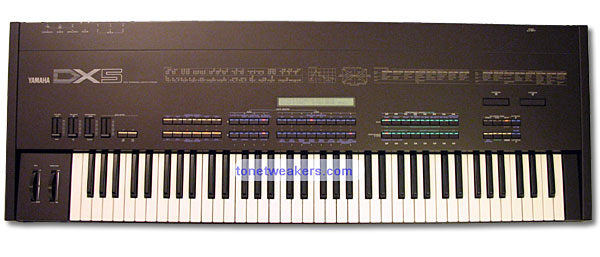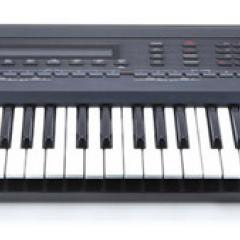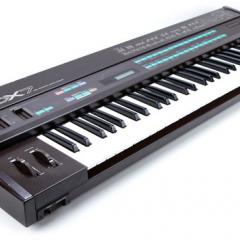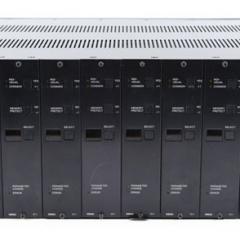Yamaha DX5

Yamaha's DX5 slots in somewhere between their legendary DX7 and flagship DX1 synthesizers. Under the hood the DX5 is almost identical to the DX1 except the DX5 has done away with the heavy wood-paneling and has a less fancy keyboard (no more ployphonic aftertouch) and is more affordable. With its dual 6-operator FM synth engines the DX5 is like having two DX7 synthesizers in one, and then some! The DX5 has 64 performance memories which can be loaded or saved to cartridge, while the DX7 has only one manual performance memory. This improves the versatility for live performance and makes excellent use of the dual engines. However, one thing to consider is that the MIDI implementation, while adequate, does not qualify it as a master keyboard, in particular, the DX5 (like the DX7) sends only 99 as the maximum velocity, not 127. In addition, the DX5 is slightly noisier than the DX7.
Although the DX5 is a digital synthesizer, its sounds are unique and fresh with an analog/digital hybrid feel. Programming however, is not at all like analog synth programming. All DX series synths use Frequency Modulation (FM) synthesis and all are rather difficult to program or, at least, difficult to understand what to program. The DX5 is no exception to this rule except that its layout, parameter buttons and displays are much better than typical DX synths.
For performances, the DX5 shares the DX1's bitimbric ability to play two patches from memory (Channel A and B) with the keyboard in layer or split mode and the polyphony reduced from 32 to 16 voices. That's a very cool ability for an old synth, especially a DX type synth. Imagine playing bass in one hand and some other wacky sounds in the other hand. You'd have to get a couple TX7s or DX7s to achieve that otherwise (of course this may be cheaper than getting a DX5 anyway). The DX5 remains a very high quality vintage instrument and if you've got the money to burn and a desire for a unique instrument from the DX line of synths, this is the one! It has been used by Kitaro.
Demos & Media

Specifications
Websites of Interest
Resources
Images from Tone Tweakers.







